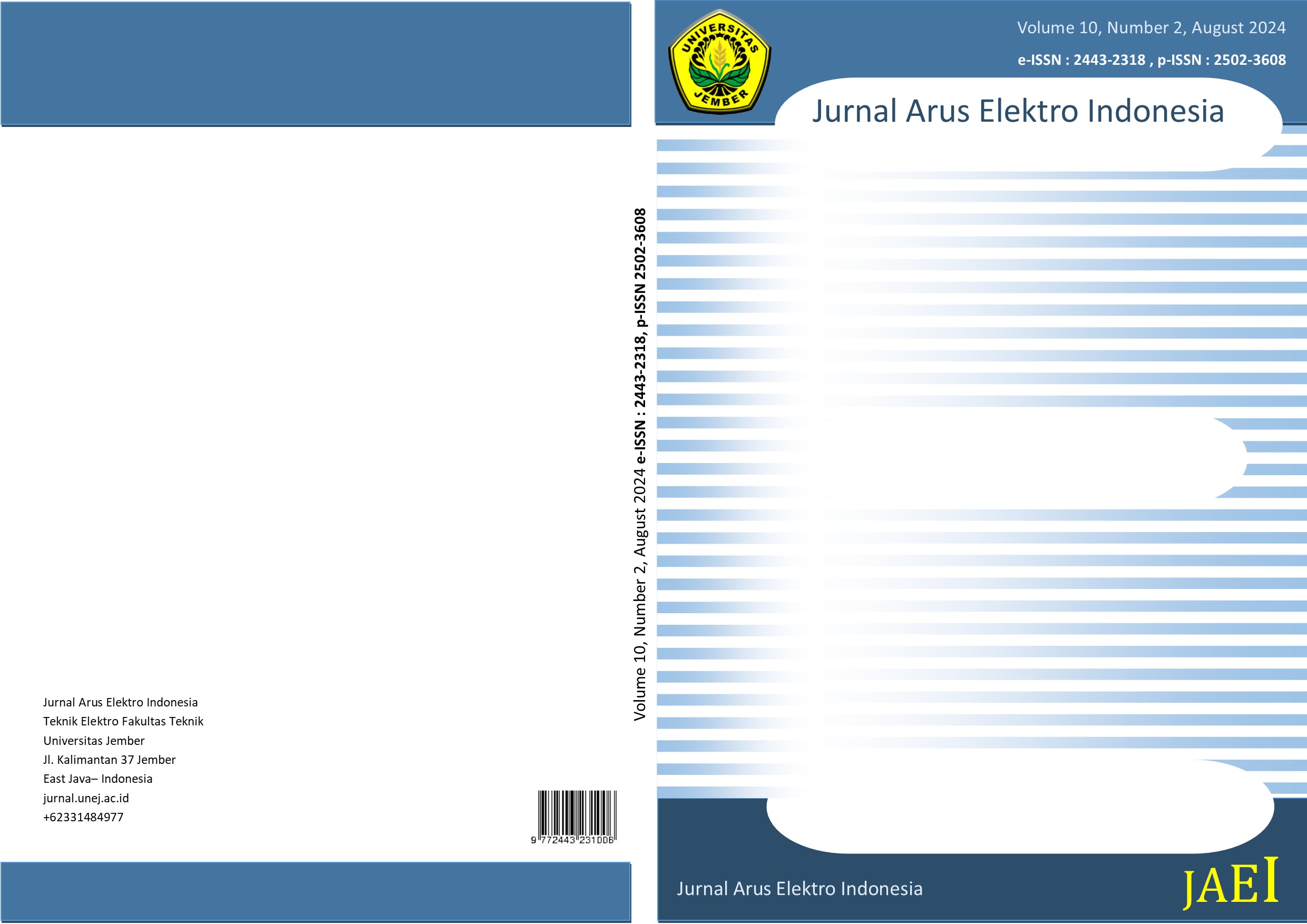Analisa Karakteristik Permanent Magnet Synchronous Motor Menggunakan Matlab-Simulink
DOI:
https://doi.org/10.19184/jaei.v10i2.37947Keywords:
Karakteristik Motor, Motor Listrik, PMSMAbstract
Penggunaan motor listrik menghabiskan energi listrik mencapai dua kali lipat dari pencahayaan, yaitu mencapai 46% dari konsumsi listrik global. Permanent magnet synchronous motor (PMSM) memiliki efisiensi yang lebih tinggi dibandingkan dengan motor induksi. Dalam pengembangan PMSM dibutuhkan pemahaman akan karakteristik jenis motor ini. Analisa karakteristik PMSM telah dilakukan dengan memodelkan motor secara matematis dari tiga fasa menjadi dq beserta hubungan antara tegangan, arus, kecepatan putar, dan torsi motor. Dengan adanya simulasi ini memudahkan pengguna untuk mengubah-ubah parameter motor untuk mengetahui pengaruhnya terhadap karakteristik motor.
Downloads
References
[2] P. Pillay, R. Krishnan, Modeling, simulation, and analysis of permanentmagnet motor drives. Part I. The permanent-magnet synchronous motor drive, IEEE Transactions on Industry Application, vol.25, no.2, 1989, pp.265-273I. S. Jacobs and C. P. Bean, “Fine particles, thin films and exchange anisotropy,†in Magnetism, vol. III, G. T. Rado and H. Suhl, Eds. New York: Academic, 1963, pp. 271–350.
[3] T. Rudnicki, R. Czerwinski, “Examination of Electromagnetic Noises and Practical Operations of a PMSM Motor driven by a DSP and Controlled by means of Field Oriented Controlâ€, elektronika ir Elektrotechnika, no. 5, pp. 46–50, 2014.
[4] L. Jarzebowicz, “Indirect Measurement of Motor Current Derivatives in PMSM Sensorless Drivesâ€, Elektronika ir Elektrotechnika, no. 5, pp. 23–26, 2014.
[5] J. Agrawal and S. Bodkhe. 2015. Low speed sensorless control of PMSM drive using high frequency signal injection. Annual IEEE India Conference (INDICON) pp. 1-6.
[6] M. R. Djalal, A. Imran, M. Ali, and H. Setiadi. 2017. Modifikasi Desain PID Controller Pada Permanent Magnet Synchronous Motor Dengan Flower Pollination Algorithm. J. Tek. Elektro-ITP vol. 6 no. 2 pp. 163–169.
[7] M. Yilmaz. 2015. Limitations/capabilities of electric machine technologies and modeling approaches for electric motor design and analysis in plug-in electric vehicle applications. Renewable and Sustainable Energy Reviews vol. 52 pp. 80-99.
[8] O. M. Arafa, G. A. A. Aziz, M. I. A. El-Sebah, and A. A. Mansour. 2016. Observer-based sensorless speed control of PMSM: A focus on drive’s startup. Journal of Electrical Systems and Information Technology vol. 3 pp. 181209.
[9] P. Pillay and R. Krishnan. 1991. Application characteristics of permanent magnet synchronous and brushless DC motors for servo drives. IEEE Transactions on industry applications vol. 27 pp. 986-996.
[10] P. Vas. 1998. Sensorless Vector and Direct Torque Control. New York, USA: Oxford University Press.
[11] S. Singh and A. Tiwari. 2017. Various techniques of sensorless speed control of PMSM. Second International Conference on Electrical, Computer and Communication Technologies (ICECCT) pp. 1-6.
[12] S.K. Sul. 2011. Control of Electric Machine Drive Systems. vol. 88: John Wiley & Sons, 2011.
[13] P. Waide, Energy Efficiency Policy Opportunities for Electric Motor Driven Systems, France: International Energy Agency, 2011.
[14] M. Melfi and S. D. Rogers, "Permanent-Magnet Motors for Energy Savings in Industrial Applications," IEEE Transactions On Industry Applications, pp. 1360-1366, 2008.
[15] J. Kim, "Speed Control of Interior Permanent Magnet PM Syncronous Motor Drives for the Flux Weakening Operation," IEEE Transction on Ind. Application, pp. 43-48, 1997.
[16] A. Kamalaselvan and S. L. Prakash, "Modeling simulation and analysis of closed loop speed control of PMSM drive system," 2014 International Conference on Circuits, Power and Computing Technologies [ICCPCT-2014], 2014, pp. 692-697, doi: 10.1109/ICCPCT.2014.7055050.
Downloads
Published
Issue
Section
License
Sebagai penulis yang sesuai naskah dan atau atas nama semua penulis, saya menjamin bahwa :
- Naskah yang diajukan adalah karya asli saya/kami sendiri.
- Naskah belum dipublikasikan dan tidak sedang diajukan atau dipertimbangkan untuk diterbitkan di tempat lain.
- Teks, ilustrasi, dan bahan lain yang termasuk dalam naskah tidak melanggar hak cipta yang ada atau hak-hak lainnya dari siapa pun.
- Sebagai penulis yang sesuai, saya juga menjamin bahwa "JAEI Editor Journal" tidak akan bertanggung jawab terhadap semua klaim hak cipta dari pihak ketiga atau tuntutan hukum yang dapat diajukan di masa depan, dan bahwa saya akan menjadi satu-satunya orang yang akan bertanggung jawab dalam kasus tersebut.
- Saya juga menjamin bahwa artikel tersebut tidak mengandung pernyataan memfitnah atau melanggar hukum.
- Saya/kami tidak menggunakan metode yang melanggar hukum atau materi selama penelitian.
- Saya/kami memperoleh semua izin hukum yang berkaitan dengan penelitian,
- Saya/kami berpegang pada prinsip-prinsip etika selama penelitian.
- Saya/kami bersedia apabila artikel kami dipublikasikan oleh tim redaksi JAEI



